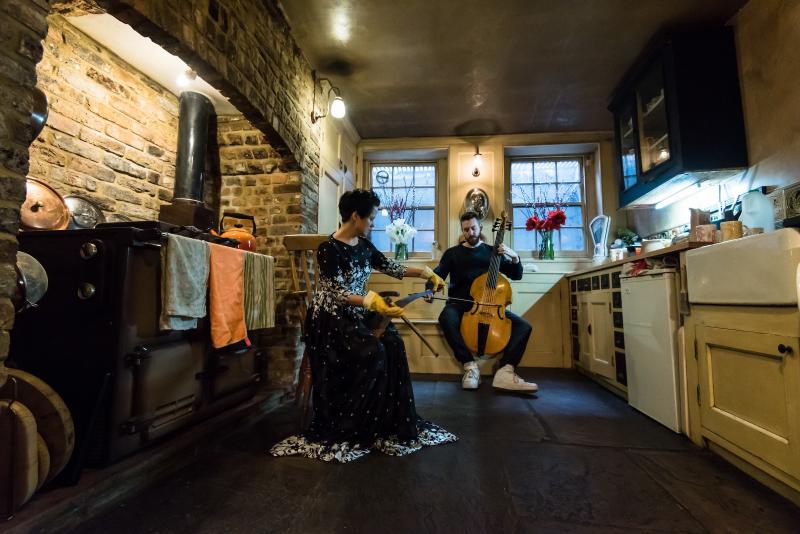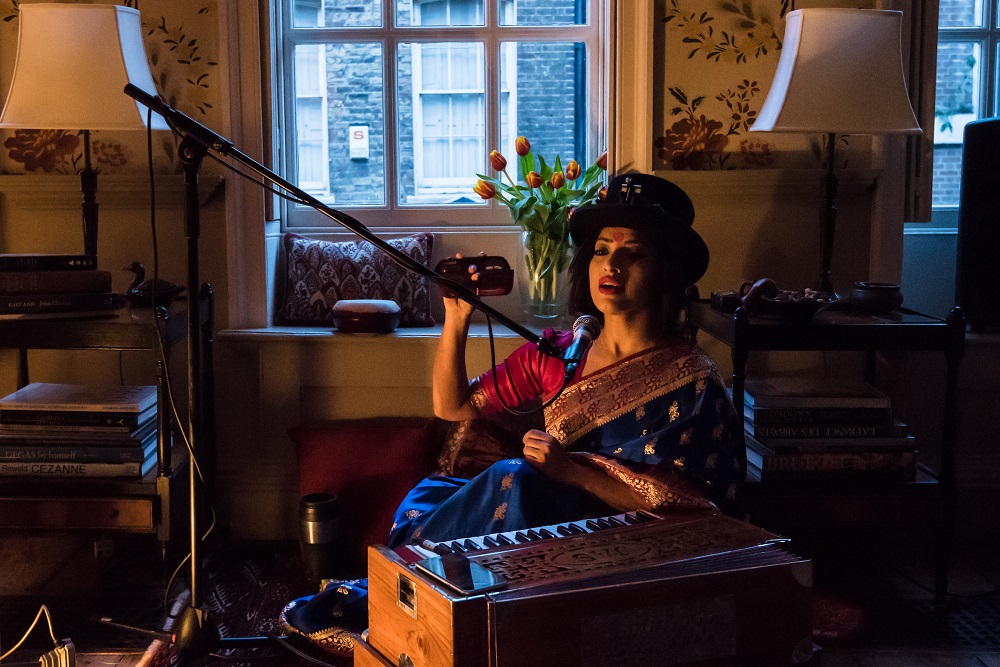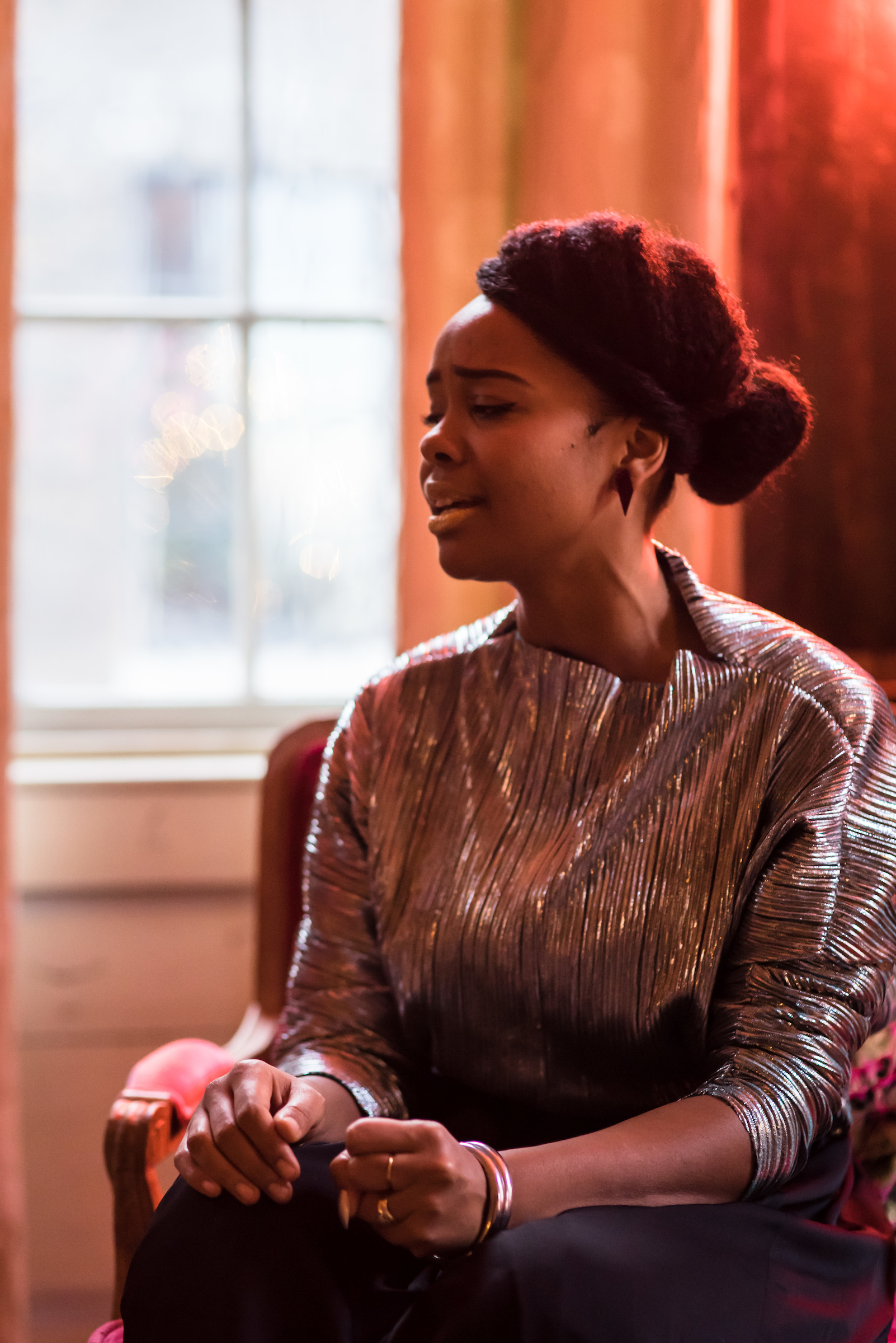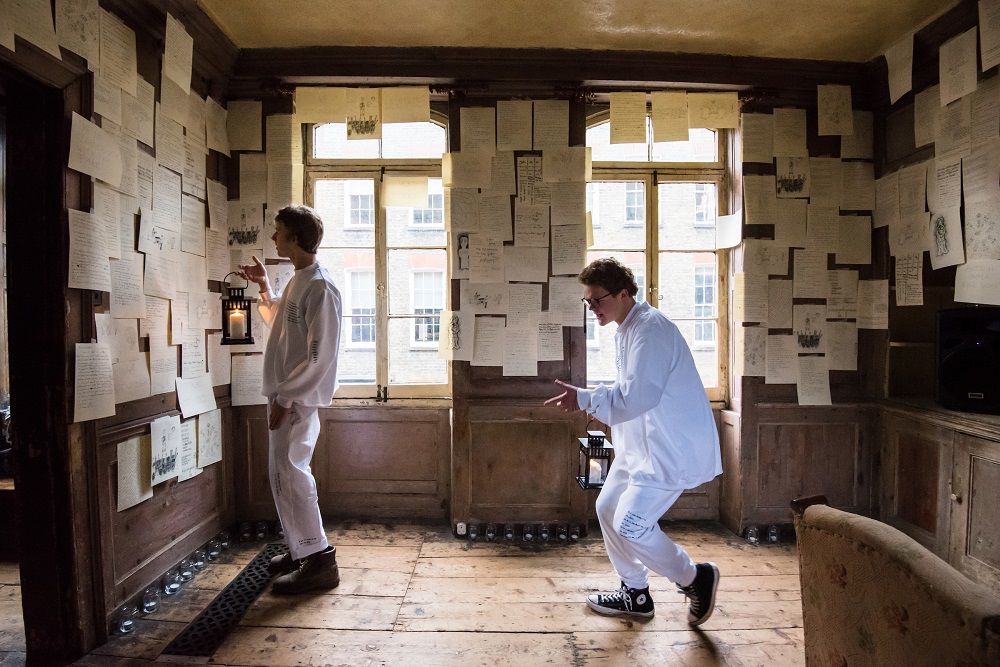Schumann Street, Spitalfields Festival review - illumination on a winter's night | reviews, news & interviews
Schumann Street, Spitalfields Festival review - illumination on a winter's night
Schumann Street, Spitalfields Festival review - illumination on a winter's night
More than a snoop around East End town houses: 'Dichterliebe' in startling focus

An icy, wet wind snuck under the door of house number 8 in Fournier Street, where Uri Caine, bundled in coat and woolly hat, conjured Schumann’s darkly powerful "Im Rhein". Beside him, perched on a weaver’s stool, was improvising legend Phil Minton, rasping, whistling and groaning his way through "The wilderness of my life".
This was Schumann Street, an enchanted mystery tour through Schumann’s Dichterliebe in the 18th-century Huguenot houses that lurk behind today’s sanitised Spitalfields market. Any idea of house-snooping and Aga-envy was lost in the challenge of hunting down the houses in dark streets glittering with snow. In a world of shadows, cold and confined spaces, Schumann felt very close. Brainchild of Spitalfield’s artistic curator André de Ridder, it was surely one of the most beguiling and illuminating festival events of 2017, an inspired musical advent calendar.  I failed to follow the cycle in order, or to catch every song, not that it mattered: the "glorious month of May" of the opening was warmed into being by Shapla Salique (pictured above), at the foot of a Christmas tree like some bejewelled gift, intoning a melismatic Bengali song. Down in the house’s basement kitchen, soprano Katherine Manley as Clara Wieck was writing letters to Robert Schumann (James McVinnie, at the organ) and singing "When I look into your eyes" with piercing sincerity. Such was their still, charged union our presence felt like an intrusion.
I failed to follow the cycle in order, or to catch every song, not that it mattered: the "glorious month of May" of the opening was warmed into being by Shapla Salique (pictured above), at the foot of a Christmas tree like some bejewelled gift, intoning a melismatic Bengali song. Down in the house’s basement kitchen, soprano Katherine Manley as Clara Wieck was writing letters to Robert Schumann (James McVinnie, at the organ) and singing "When I look into your eyes" with piercing sincerity. Such was their still, charged union our presence felt like an intrusion.
 In the corner of an upstairs room, Abinaro (pictured right) took a radical approach to "Ich grolle nicht" ("I don’t complain") transforming that heroic cry of stoicism into painfully sweet grief, recast as a hypnotic R&B ballad using the original imagery, with soft electric guitar chords. Her quiet poise embodied the song. Up another set of rickety stairs and here was soprano Héloïse Werner, amplifying the intensity of "Und wüsstens die Blumen" to operatic proportions: while Werner spoke and sung of her anguished, torn heart, Anne Denholm’s dissected her harp in extraordinary ways, from shivering filigree, to jarring feedback, drooping bent notes and the ghostly wail of metal on strings. Werner ended with a prolonged, sobbing cry of pitches, the harp drifting to nothing.
In the corner of an upstairs room, Abinaro (pictured right) took a radical approach to "Ich grolle nicht" ("I don’t complain") transforming that heroic cry of stoicism into painfully sweet grief, recast as a hypnotic R&B ballad using the original imagery, with soft electric guitar chords. Her quiet poise embodied the song. Up another set of rickety stairs and here was soprano Héloïse Werner, amplifying the intensity of "Und wüsstens die Blumen" to operatic proportions: while Werner spoke and sung of her anguished, torn heart, Anne Denholm’s dissected her harp in extraordinary ways, from shivering filigree, to jarring feedback, drooping bent notes and the ghostly wail of metal on strings. Werner ended with a prolonged, sobbing cry of pitches, the harp drifting to nothing.
The song of "old fairy tales" belonged, appropriately, in the front room of a house graced with a stuffed bear, and a snarling fox on the wall behind tenor Robert Murray’s head. There was something especially thrilling to feel the heat of his clarion voice a few feet away, blazing into that pannelled room like a fiery torch. Andrew West, playing on a soft baby grand, not perfectly tuned, lent intimacy to the performance.
A stroke of genius turned the final "coffin" Lied into something both ordinary and transcendent. Mara Carlyle sang while washing cups at the sink, her naked voice, grainy and low in the shadowy, stone-flagged kitchen, adorned only with sparse plucked notes of Liam Byrne’s viol. That heavenly final coda was rendered by Byrne in fragmentary, half-whispered phrases, while she completed the melody on a bowed saw, a high, chill voice from beyond the grave.  My last visit felt like the ultimate conclusion, a nightmare vision inside the composer’s brain: "When I hear the little song" was taken by Apollo 47 (pictured above), two German hip-hop artists careering around a room plastered in poetry and drawings. As they rapped with rhythmic, jeering irony on Heine's "enormous pain", you couldn’t help but think of the asylum in Endenich, where Schumann was confined and consumed.
My last visit felt like the ultimate conclusion, a nightmare vision inside the composer’s brain: "When I hear the little song" was taken by Apollo 47 (pictured above), two German hip-hop artists careering around a room plastered in poetry and drawings. As they rapped with rhythmic, jeering irony on Heine's "enormous pain", you couldn’t help but think of the asylum in Endenich, where Schumann was confined and consumed.
Nothing can improve upon Dichterliebe, but Schumann Street, in myriad ways, brought its bittersweet songs up so close you could reach out and touch them.
The future of Arts Journalism
You can stop theartsdesk.com closing!
We urgently need financing to survive. Our fundraising drive has thus far raised £49,000 but we need to reach £100,000 or we will be forced to close. Please contribute here: https://gofund.me/c3f6033d
And if you can forward this information to anyone who might assist, we’d be grateful.

Subscribe to theartsdesk.com
Thank you for continuing to read our work on theartsdesk.com. For unlimited access to every article in its entirety, including our archive of more than 15,000 pieces, we're asking for £5 per month or £40 per year. We feel it's a very good deal, and hope you do too.
To take a subscription now simply click here.
And if you're looking for that extra gift for a friend or family member, why not treat them to a theartsdesk.com gift subscription?
more Classical music
 Jansen, LSO, Pappano, Barbican review - profound and bracing emotional workouts
Great soloist, conductor and orchestra take Britten and Shostakovich to the edge
Jansen, LSO, Pappano, Barbican review - profound and bracing emotional workouts
Great soloist, conductor and orchestra take Britten and Shostakovich to the edge
 Jakub Hrůša and Friends in Concert, Royal Opera review - fleshcreep in two uneven halves
Bartók kept short, and a sprawling Dvořák choral ballad done as well as it could be
Jakub Hrůša and Friends in Concert, Royal Opera review - fleshcreep in two uneven halves
Bartók kept short, and a sprawling Dvořák choral ballad done as well as it could be
 Hadelich, BBC Philharmonic, Storgårds, Bridgewater Hall, Manchester review - youth, fate and pain
Prokofiev in the hands of a fine violinist has surely never sounded better
Hadelich, BBC Philharmonic, Storgårds, Bridgewater Hall, Manchester review - youth, fate and pain
Prokofiev in the hands of a fine violinist has surely never sounded better
 Monteverdi Choir, ORR, Heras-Casado, St Martin-in-the-Fields review - flames of joy and sorrow
First-rate soloists, choir and orchestra unite in a blazing Mozart Requiem
Monteverdi Choir, ORR, Heras-Casado, St Martin-in-the-Fields review - flames of joy and sorrow
First-rate soloists, choir and orchestra unite in a blazing Mozart Requiem
 Cho, LSO, Pappano, Barbican review - finely-focused stormy weather
Chameleonic Seong-Jin Cho is a match for the fine-tuning of the LSO’s Chief Conductor
Cho, LSO, Pappano, Barbican review - finely-focused stormy weather
Chameleonic Seong-Jin Cho is a match for the fine-tuning of the LSO’s Chief Conductor
 Classical CDs: Shrouds, silhouettes and superstition
Cello concertos, choral collections and a stunning tribute to a contemporary giant
Classical CDs: Shrouds, silhouettes and superstition
Cello concertos, choral collections and a stunning tribute to a contemporary giant
 Appl, Levickis, Wigmore Hall review - fun to the fore in cabaret and show songs
A relaxed evening of light-hearted fare, with the accordion offering unusual colours
Appl, Levickis, Wigmore Hall review - fun to the fore in cabaret and show songs
A relaxed evening of light-hearted fare, with the accordion offering unusual colours
 Lammermuir Festival 2025, Part 2 review - from the soaringly sublime to the zoologically ridiculous
Bigger than ever, and the quality remains astonishingly high
Lammermuir Festival 2025, Part 2 review - from the soaringly sublime to the zoologically ridiculous
Bigger than ever, and the quality remains astonishingly high
 BBC Proms: Ehnes, Sinfonia of London, Wilson review - aspects of love
Sensuous Ravel, and bittersweet Bernstein, on an amorous evening
BBC Proms: Ehnes, Sinfonia of London, Wilson review - aspects of love
Sensuous Ravel, and bittersweet Bernstein, on an amorous evening
 Presteigne Festival 2025 review - new music is centre stage in the Welsh Marches
Music by 30 living composers, with Eleanor Alberga topping the bill
Presteigne Festival 2025 review - new music is centre stage in the Welsh Marches
Music by 30 living composers, with Eleanor Alberga topping the bill
 Lammermuir Festival 2025 review - music with soul from the heart of East Lothian
Baroque splendour, and chamber-ensemble drama, amid history-haunted lands
Lammermuir Festival 2025 review - music with soul from the heart of East Lothian
Baroque splendour, and chamber-ensemble drama, amid history-haunted lands
 BBC Proms: Steinbacher, RPO, Petrenko / Sternath, BBCSO, Oramo review - double-bill mixed bag
Young pianist shines in Grieg but Bliss’s portentous cantata disappoints
BBC Proms: Steinbacher, RPO, Petrenko / Sternath, BBCSO, Oramo review - double-bill mixed bag
Young pianist shines in Grieg but Bliss’s portentous cantata disappoints

Add comment